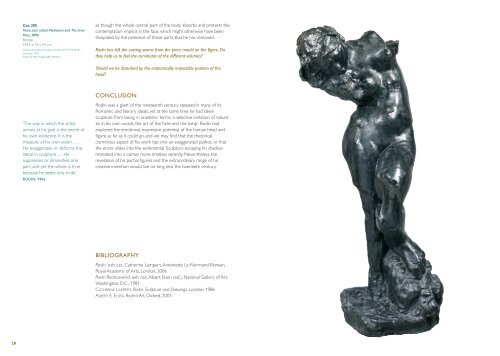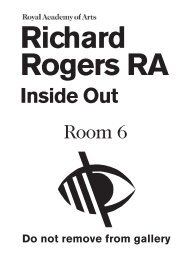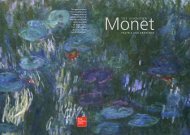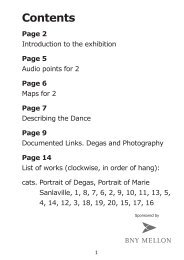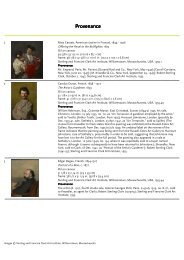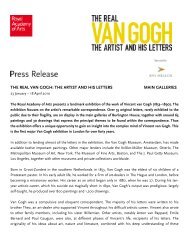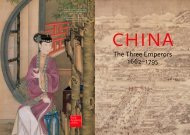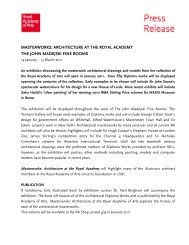rodin - Royal Academy of Arts
rodin - Royal Academy of Arts
rodin - Royal Academy of Arts
Create successful ePaper yourself
Turn your PDF publications into a flip-book with our unique Google optimized e-Paper software.
20<br />
Cat. 205<br />
Muse, also called Meditation and The Inner<br />
Voice, 1896<br />
Bronze<br />
144.5 x 75 x 54 cm<br />
Victoria and Albert Museum, London, A36-1914. Rodin<br />
Donation, 1914<br />
Photo © V&A Images/V&A Museum<br />
‘The way in which the artist<br />
arrives at his goal is the secret <strong>of</strong><br />
his own existence. It is the<br />
measure <strong>of</strong> his own vision ….<br />
He exaggerates or deforms the<br />
literal in sculpture … He<br />
suppresses or diminishes one<br />
part; and yet the whole is true<br />
because he seeks only truth.’<br />
RODIN, 1906<br />
as though the whole central part <strong>of</strong> the body absorbs and protects the<br />
contemplation implicit in the face, which might otherwise have been<br />
dissipated by the presence <strong>of</strong> those parts that he has removed.<br />
Rodin has left the casting seams from the piece mould on the figure. Do<br />
they help us to feel the curvatures <strong>of</strong> the different volumes?<br />
Should we be disturbed by the anatomically impossible position <strong>of</strong> the<br />
head?<br />
CONCLUSION<br />
Rodin was a giant <strong>of</strong> the nineteenth century steeped in many <strong>of</strong> its<br />
Romantic and literary ideals, yet at the same time he had taken<br />
sculpture from being, in academic terms,‘a selective imitation <strong>of</strong> nature’<br />
to, in his own words, the art <strong>of</strong> the ‘hole and the lump’. Rodin had<br />
explored the emotional, expressive potential <strong>of</strong> the human head and<br />
figure as far as it could go, and we may find that the rhetorical,<br />
clamorous aspect <strong>of</strong> his work tips into an exaggerated pathos, or that<br />
the erotic slides into the sentimental. Sculptors escaping his shadow<br />
retreated into a calmer, more timeless serenity. Nevertheless, the<br />
revelation <strong>of</strong> his partial figures and the extraordinary range <strong>of</strong> his<br />
creative invention would live on long into the twentieth century.<br />
BIBLIOGRAPHY<br />
Rodin, exh. cat., Catherine Lampert, Antoinette Le Normand-Romain,<br />
<strong>Royal</strong> <strong>Academy</strong> <strong>of</strong> <strong>Arts</strong>, London, 2006<br />
Rodin Rediscovered, exh. cat., Albert Elsen (ed.), National Gallery <strong>of</strong> Art,<br />
Washington, D.C., 1981<br />
CATHERINE LAMPERT, Rodin: Sculpture and Drawings, London, 1986<br />
ALBERT E. ELSEN, Rodin’s Art, Oxford, 2003


